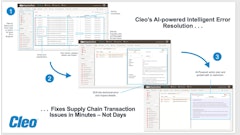No matter what industry you’re in, if you buy and/or sell a product or service, you should recognize the massive opportunities to optimize project and procurement processes—saving your business time and money.
As the business landscape shifts, systems for collaboration and handling increasingly complex projects are critical to competing for bigger and better business, as the recent benchmark entitled “2014 Project & Procurement Management Benchmark” produced by Noosh, Inc. uncovered.
These trends are based on the proprietary data of over 5,000 companies handling nearly $12 billion in annual transactions and a recent industry survey that uncovered common industry perceptions.
As you begin planning for 2015, it would be prudent to consider including these growing trends for project and procurement management in your business strategies.
Collaborative Sourcing
Sole sourcing, contracts, rate cards and auction sourcing methodologies all have their places, but savvy businesses should consider a collaborative sourcing approach. Project costs could be slashed by 20.7 percent simply by having several capable suppliers compete for business on a central reportable platform.
To begin optimizing your projects to collaboratively bid (when appropriate), start with clearly organizing your existing supplier community into groups based on their core competencies, existing behavior and response times. These groups can allow you to manage your supplier rotation more effectively, and thereby, elicit the best estimates and lowest costs.
Deliverable-Based Project Management
New research shows that, while project turn times remain steady, the number of deliverables for each project jumped by nearly 48 percent, which means businesses must deliver more complex projects in the same amount of time as previously less complex projects to remain competitive.
Make your employees more productive by focusing on deliverables while managing projects instead of tasks. According to respondents to a recent industry survey, 44.3 percent stated that they (or their employees) could manage 250 deliverables or less per year, and 30 percent said that they manage only 175 or less per year. An average user of a deliverable-based project and procurement management system can manage 553 deliverables per year, with the top 20 percent of respondents indicating they were capable of managing 2,009 or more deliverables.
Focus on empowering employees through technology to work on end-goal deliverables vs. project-related busy work to create a greater sense of progress for employees, resulting in higher engagement and greater productivity.
Collaborative Change Management
A large portion of the industry (33 percent) views change orders as a necessary part of the project management and procurement process, yet users of a system that enables transparent collaboration and change management write change orders that raise project costs only 5.3 percent of the time.
Invest in a system that allows all stakeholders to collaborate on project requirements before the project is submitted for estimate. This single system of record can prevent many errors, costly rework or missing communications about the project—all of which contribute to change orders that increase overall project costs.
Results
Companies that employ these innovative project and procurement management strategies are able to manage a greater volume of significantly more complex projects in the same amount of time as a traditional project, all while dramatically reducing costs. These key business advantages enable these industry innovators to compete for bigger and better business, grow twice as fast as the industry average and be better prepared for the future.


![Pros To Know 2026 [color]](https://img.sdcexec.com/mindful/acbm/workspaces/default/uploads/2025/08/prostoknow-2026-color.mduFvhpgMk.png?auto=format%2Ccompress&bg=fff&fill-color=fff&fit=fill&h=100&q=70&w=100)







![Pros To Know 2026 [color]](https://img.sdcexec.com/mindful/acbm/workspaces/default/uploads/2025/08/prostoknow-2026-color.mduFvhpgMk.png?ar=16%3A9&auto=format%2Ccompress&bg=fff&fill-color=fff&fit=fill&h=135&q=70&w=240)






